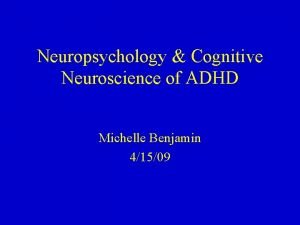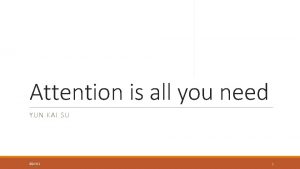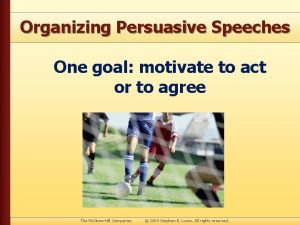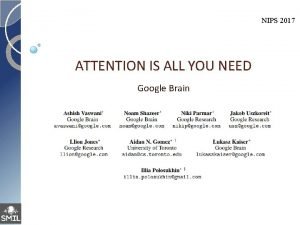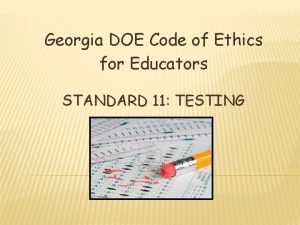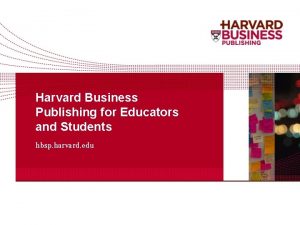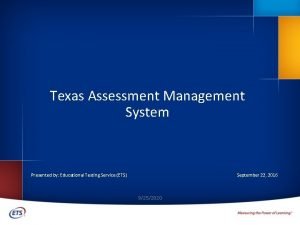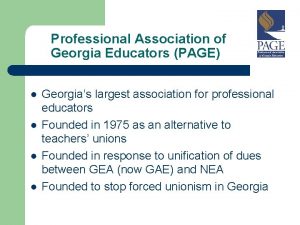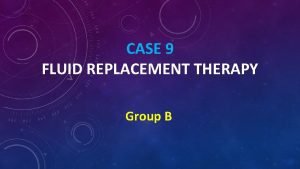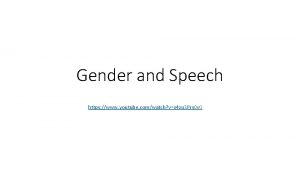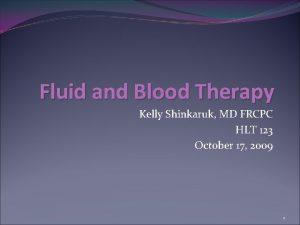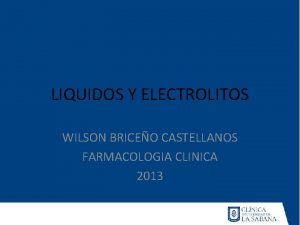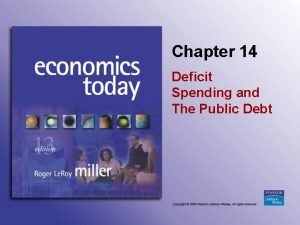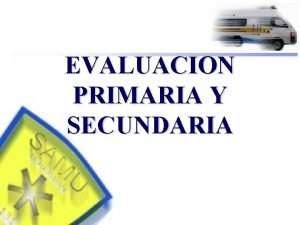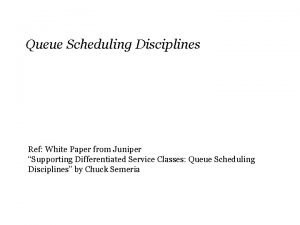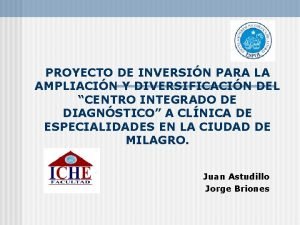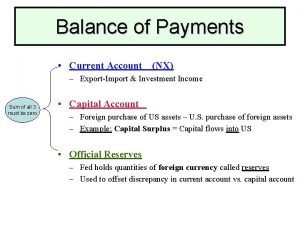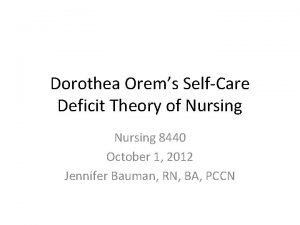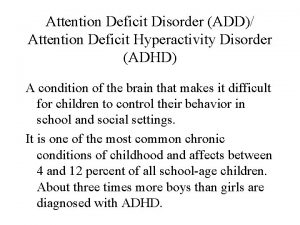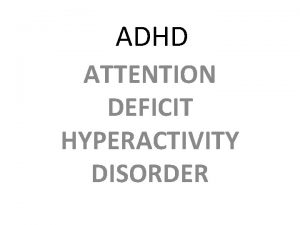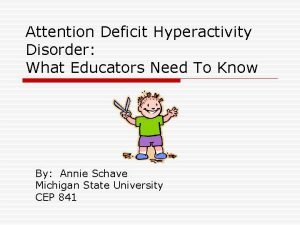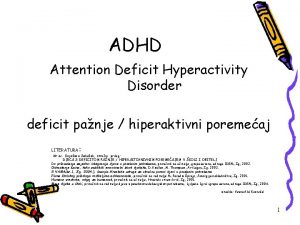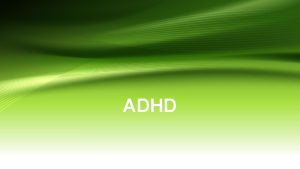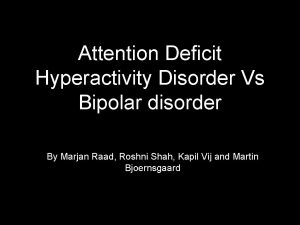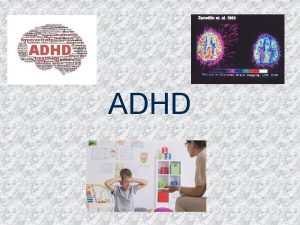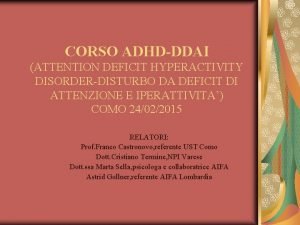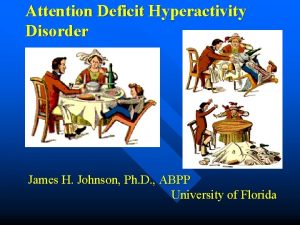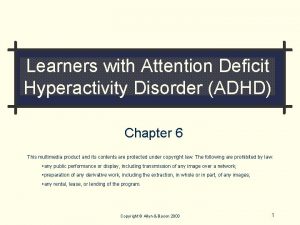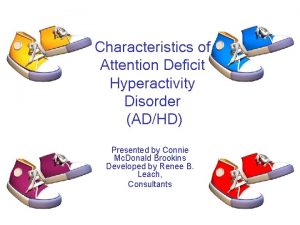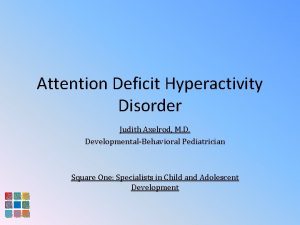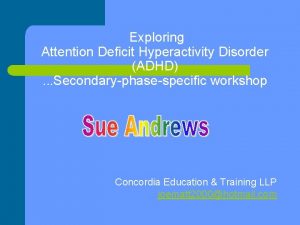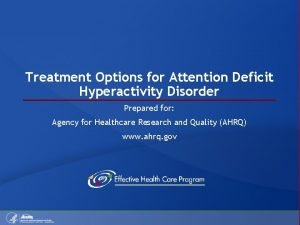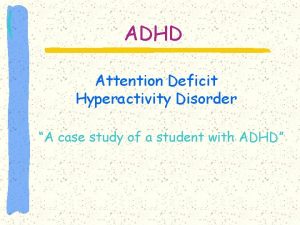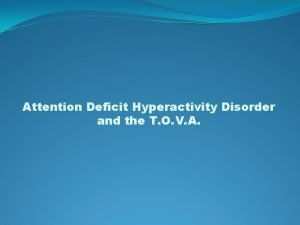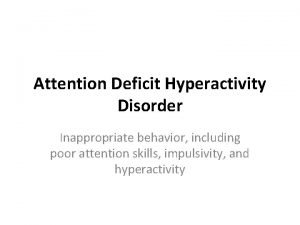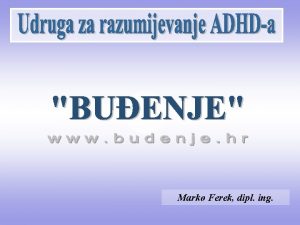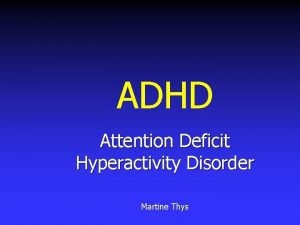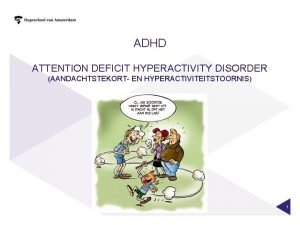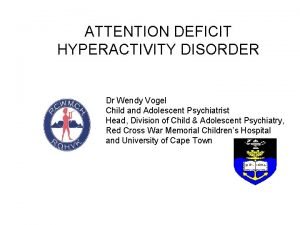Attention Deficit Hyperactivity Disorder What Educators Need To





































- Slides: 37

Attention Deficit Hyperactivity Disorder: What Educators Need To Know

What is ADHD? The American Psychiatric Association in the DSM-IV (1994) defines three main types of Attention Deficit Hyperactivity Disorder. Individuals can have predominately inattentive ADHD, predominately hyperactive-impulsive ADHD, or combined type depending on the presenting symptoms Inattention Hyperactivity-Impulsivity o. Fails to give close attention to details o. Difficulty sustaining attention in tasks o. Does not seem to listen when spoken to directly o. Often does not follow through on instructions and fails to finish schoolwork, chores, or duties in the workplace o. Often has difficulty organizing tasks and activities o. Often loses things necessary for tasks or activities o. Is often easily distracted o. Often forgetful in daily activities o. Hyperactivity -often fidgets with hands or feet or squirms in seat -often leaves seat in classroom or in other situations in which remaining seated is expected -often runs about or climbs excessively -often has difficulty playing or engaging in leisure activities -often is “on the go” or as if “driven by a motor” -talks excessively o. Impulsivity -often blurts out answers before questions are completed -has difficulty awaiting turn -interrupts or intrudes on others

Diagnostic Criteria o A: Six or more of the previously noted symptoms persisting for 6 months or longer qualifies for a diagnosis of ADHD in either the inattentive category or hyperactivity-impulsive category. If both inattentive and hyperactive-impulsive symptoms are present then a combined type diagnosis is given. o B: One of the symptoms needs to have been present before the age of 7. o C: Some impairment from the symptoms is present in two or more settings, such as school or home. o D: There must be clear and significant evidence of a social, academic, or occupational impairment. o E: The symptoms are not better accounted for by another mental disorder.

What Educators Need to Remember: o According to Schuck & Crinella (2005), “the most worrisome deficits of children with ADHD are not the product of low IQ, but rather of instability of control processes that govern everyday applications to the environment” (p. 275). o The ADHD student is not dumb, lazy, or out of control. They are smart kids who need our help to gain the proper strategies to be successful!

What Can An Educator Do If Some Symptoms Appear To Be Present? 1. Maintain behavior logs citing observations of behaviors and situations. Remember to include inventions used and their efficiency. 2. Inform parents of behavioral concerns and discuss behaviors at home. 3. Request child study or equivalent meeting with parents, special education teachers, school psychologist, etc. to discuss classroom behaviors. This can lead to diagnosis from a doctor and then an IEP for the student. 4. If needed, rating scales may be given to teachers and parents. Remember: Diagnosis and identification of ADHD needs to come by a medical evaluation from a family doctor, psychologist, or psychiatrist outside of the school system! Your job is to observe the child and find interventions that work to make that child successful!

What Rating Scales Are Used Most? o The most common rating scale used is Conners Teachers Rating Scale which will ask you to rate the behaviors and form statements about the behavior (Vaughn, Bos, & Schumm, 2006). o Similar forms may include the ADHD Rating Scale or the Behavior Rating Form based on DSM IV symptoms (Vaughn, Bos, & Schumm, 2006). o It is important to know how often the behavior occurs when completing these forms!

What Causes ADHD? o According to Barkley’s there is significant evidence that ADHD occurrences are due to biological factors. o Other factors, as stated on the previous website, may include: difficulties during pregnancy, prenatal exposure to alcohol or tobacco, low birth weight, high lead levels, and prenatal injury to the prefrontal lobe of the brain. o A recent study published in Pediatrics by scientists at Texas Tech. University shows that there is no link between ADHD and television. This is however still heavily controversial

Causes continued. . . o New research suggests that ADHD is present with dysfunctions in the prefrontal lobes of the brain. Prefrontal lobes control executive functions which children with ADHD are lacking (Dawson & Guare, 2004). These dysfunctions being studied include size differences in prefrontal regions, basal ganglia, and cerebellum. This can lead to abnormal activation patterns in the brain (Barkley, 2003). o Other research still not concluded at this time states that ADHD children have abnormal dopamine and norepinephrine levels in the brain (Barkley, 2003). o Another neurological cause is related to lower glucose levels affecting neurotransmitter activity in parts of the brain (ADDA, http: //www. add. org/articles/index. html ).

What Are Executive Functions? o An executive function is “a neuropsychological concept referring to the cognitive processes required to plan and direct activities, including task initiation and follow through, working memory, sustained attention, performance monitoring, inhibition of impulses, and goal-directed persistence. ” (Dawson & Guare, 2004, p. vii)

Why Are Executive Functions Important? o These skills allow us to “organize our behavior over time and override immediate demands in favor of longer-term goals” (Dawson & Guare, 2004, p. 1). o They also allow for the management of emotions and effective thought monitoring. o Children with problems in a particular executive function area have a deficit in that skill area.

Deficit: Response Inhibition o This is “the capacity to think before you act” (Dawson & Guare, p. 47). o Children with this deficit tend to be impulsive. They will say things without thinking about what it is that they are saying.

Deficit: Working Memory o This is “the ability to hold information mind while performing complex tasks” (Dawson & Guare, p. 49). o Students with this deficit tend to forget easily. They may forget their homework or books at school on a regular basis.

Deficit: Self-Regulation Of Affect o This is “the ability to manage emotions in order to achieve goals, accomplish tasks, or control and direct behavior” (Dawson & Guare, p. 50). o These students tend to become upset quickly with situations, unable to control their emotions. These students tend to have outbursts that disrupt daily functioning.

Deficit: Sustained Attention o This is “the capacity to maintain attention to a situation or task in spite of distractibility, fatigue, or boredom” (Dawson & Guare, p. 52). o Students with this deficit tend to have a hard time getting started on a task. These students will get up often when a task is given. They talk to other students when they shouldn’t. Their attention is on everything in the room other than their work.

Deficit: Task Initiation o This is “the ability to begin a task without undue procrastination, in a timely fashion” (Dawson & Guare, p. 54). o These students tend to put off doing work that they need to complete. They lack the processes to start the task.

Deficit: Planning o This is “the ability to create a roadmap to reach a goal or to complete a task. It also involves being able to make decisions about what’s important to focus on and what’s not important” (Dawson & Guare, p. 55). o These students tend to wait till the last minute to complete tasks and then not know what to do when they go to complete them.

Deficit: Organization o This is “the ability to arrange or place things according to a system” (Dawson & Guare, p. 58). o These students tend to have messy desks or cubbies. They lose papers often and frequently shove papers instead of placing them in appropriate spots.

Deficit: Time Management o This is “the capacity to estimate, allocate, and execute within time constraints” (Dawson & Guare, p. 60). o These children get work done at the last minute and frequently ask for assignment extensions. Also, they often use excuses for not having work.

Deficits: Goal-Directed Persistence o This is “the capacity to have a goal, follow through to the completion of the goal, and not be put off by or distracted by competing interests” (Dawson & Guare, p. 62). o These students are able to create goals for themselves but are not able to achieve them. They are not able to understand the necessary steps to reach a goal and often become distracted with outside stimuli negatively impacting their task completion.

Deficit: Flexibility o This is “the ability to revise plans in the face of obstacles, setbacks, new information, or mistakes” (Dawson & Guare, p. 63). o These students have difficulty in transitions and new situations. These students struggle longer than others at the beginning of each year. They also are thrown off by changes in daily schedules. These students have limited problem solving strategies.

Deficit: Metacognition o This is “the ability to stand back and take a bird’seye view of oneself in a situation. It is an ability to observe how you problem solve. It also includes self-monitoring and self-evaluative skills” (Dawson & Guare, p. 65). o These students make careless mistakes frequently. They also will complete one step then stop instead of finishing the series of steps. For example, these students may add instead of subtract over and over again while failing to review their work and realizing their mistake. Also, these students will do one step of long division and then stop, not reflecting on the whole process needed to complete the task.

What Are The Intervention Areas? o Educational Accommodations n Executive Functioning Deficits n Classroom Interventions o Promoting Appropriate Behavior o Medication Options n Stimulant Medication n Medication and Side Effects

Response Inhibition o Reduce situations where the child can get into trouble o Proximity Control: Increase supervision of the child o Control impulses by modeling appropriate behavior o To teach the skill: n n n Explain the skill and behaviors Model behaviors Discussion situations to use the skill Reinforce the skill Ignore inappropriate behavior

Working Memory o Enforce use of assignment books consistently o Utilize checklists and to-do lists o Use cue devices such as verbal reminders, alarm clocks, and Post-Its o To teach the skill: n Explain the skill n Give options to the child for cues and checklists to use n Create a monitoring system for the child to monitor their own skill usage

Self-Regulation Of Affect o Prepare child for problem situations o Give child scripts for problem situations and practice regularly o Structure environment to avoid situations that can lead to problems o Break tasks down into small steps o Give breaks to child during tasks as needed o Teach child I-statements o Use social stories that teach emotional control o To teach this skill: n n n Explain the skill Provide coping strategies Practice with the child Reinforce child when strategies are used Discuss real life situations of using the strategy

Sustained Attention Write start and stop times on assignments Use incentive systems Break down tasks into steps Make tasks interesting for students Give child something fun to do when task is completed Provide attention and praise when student is remaining on task o To teach the skill: n Discuss attention time with the student n Teach them to break down tasks on their own n Help them make work plans for completing tasks n Reinforce them when they use the plan o o o

Task Initiation o Use verbal cues to get child started o Create a visual cue to prompt child to get started, such as a note on their desk o Walk through the first part of the task to help child get started o Have child tell you when they will begin the task and cue them when the time arrives o To teach the skill: n Teach the child to create a written plan for starting the n n task including time and type of task Teach child to break down the task if needed Teach child to use cue such as alarm clock to start task Reinforce child when no additional cues are needed Fade supervision

Planning o Plan a schedule for the child o Use rubrics o Break long assignments into smaller pieces with deadlines for each piece o Create planning sheets with due dates o Use assignment planners o To teach the skill: n Walk through the planning process with the child n Have child model the planning process n Tell student to create roadmaps for tasks n Ask questions such as “What do you have to do first? ”

Organization o Maintain an organized classroom o Create schemes for organizing backpacks and folders o Color-code folders, notebooks, and papers for classes o To teach the skill: n Teach child to separate papers and categorize them n Have them create their own organization plan o Get the plan in writing o Have them implement the plan

Time Management Give child a schedule to follow Prompt student with each step of a task Impose time limits for assignments Provide frequent reminders for remaining time to complete task o Use cueing devices such as alarm clocks o To teach the skill: n Help child understand what the task involves n Have child think of distractions that may be present o o n n when completing task Create an estimated time for completion; compare estimated time to actual time Find strategies to decrease distractions

Goal-Directed Persistence o Give students goals and have them keep track of their progress o Goals need to have motivational interest to the student o Include students in establishing goals o Create reasonable goals o To teach the skill: n Follow a coaching process: o Hold a goal setting session where a goal is set, obstacles are discussed and a plan is written o Hold daily coaching sessions where goal is re-discussed and progress is assessed by asking questions

Flexibility Give advance warning for new schedules or activities Allow student to practice new schedules or activities Provide rubrics to follow Read social stories to teach coping strategies in problem situations o Offer positive reinforcement and step by step assistance with difficult problems o To teach the skill: n Teach students what inflexibility is and how to recognize it n Teach and model coping strategies with plans and cues n Create strategies to fall back on n Teach relaxation strategies o o

Metacognition o Ask child to explain how they solved the problem or if they can think of another way to solve the problem. o Create buddy systems for students to check work. o Give assignments where students can evaluate their work ethic and give a grade. o Use rubrics. o To teach the skill: n Define the skill and what is needed to use the skill appropriately n Practice the skill n Create error-monitoring checklists n Teach children to ask themselves self-monitoring questions while tasks are being completed

Classroom Setup To Accommodate ADHD o Seat ADHD student away from distractions, preferably front and center (www. addinschools. com). o Seat student near a good role model (www. addinschools. com). o Increase distance between desks to decrease distractions (www. addinschools. com). o Create a cool-down area (National Education Association, 2005). o Play quiet music (Appelbaum Training Institute’s How to Handle the Hard-to-Handle Student Resource Handbook, (2005). o Create a stage for announcements in the classroom (Appelbaum Training Institute’s How to Handle the Hard-to-Handle Student Resource Handbook, (2005).

How To Promote Appropriate Behavior In The Classroom o Use positive reinforcement regularly. o Implement Class-wide problem solving strategies such as FAST or SLAM. o Practice Positive Behavioral Support by conducting functional behavior assessments to create individualized interventions. o Hold class meetings that teach and reinforce proper social skills, acceptance of others and conflict resolution.

Medicinal Treatments o Miernicki & Hukriede (2004) found that most elementary school teachers and middle school teachers feel that stimulant medications along with interventions work best to help children with ADHD. o Stimulant medication is used to alter perceptions and feelings making the student more successful by targeting the areas of the brain that effect executive functioning (Miernicki & Hukriede, 2004; Schuck & Crinella, 2005). o 70 to 80% of children on psychostimulant medications respond positively to them because they help communication between nerve networks in the brain (www. help 4 adhd. org).

Commonly Used Medications o Stimulants n Ritalin, Concerta, Metadate, Focalin, Adderall, Dexadrine n Given in short-acting (4 -6 hours) or long-acting (6 -12 hours) doses n Side Effects: difficulty sleeping, lack of appetite, fatigue, headache, stomach-ache, possible occurances of motor tics o Nonstimulants n Strattera, antidepressants such as Zoloft or Celexa n Affect dopamine and norepinephrine levels in the brain n Side Effects: difficulty sleeping, lack of appetite, fatigue, headache, stomach-ache
 Malingering
Malingering Alternating attention vs divided attention
Alternating attention vs divided attention I need attention
I need attention Monroe's motivated sequence
Monroe's motivated sequence Attention is all you need nips
Attention is all you need nips Lean innovation educators summit
Lean innovation educators summit Earth educators rendezvous
Earth educators rendezvous Georgia code of ethics for educators
Georgia code of ethics for educators New york harm reduction educators
New york harm reduction educators Georgia code of ethics for educators
Georgia code of ethics for educators Harvard business educators
Harvard business educators Allied educator moe
Allied educator moe Missouri educators trust
Missouri educators trust Texas assessment managment system
Texas assessment managment system Measurement and evaluation for health educators
Measurement and evaluation for health educators Professional association of georgia educators
Professional association of georgia educators Maintenance fluid formula 4-2-1
Maintenance fluid formula 4-2-1 Budžetski deficit
Budžetski deficit Severe dka criteria
Severe dka criteria Soup_nn
Soup_nn Pamela fishman gender theory
Pamela fishman gender theory Fluid deficit calculation
Fluid deficit calculation Deficit calorico
Deficit calorico Formula corrección de sodio
Formula corrección de sodio Javni dug srbije po godinama
Javni dug srbije po godinama Deficit in balance of payment
Deficit in balance of payment Deficit spending exists when
Deficit spending exists when Deficit sebaopatery
Deficit sebaopatery Inversion fija y diferida
Inversion fija y diferida Deficit sacharázy
Deficit sacharázy Escala pirrl
Escala pirrl Bicarbonate deficit calculation
Bicarbonate deficit calculation Deficit weighted round robin
Deficit weighted round robin Hypokalemia signs and symptoms
Hypokalemia signs and symptoms Balance de equipos
Balance de equipos Current account deficit vs surplus
Current account deficit vs surplus Budžetski deficit
Budžetski deficit Dorothea orems
Dorothea orems

